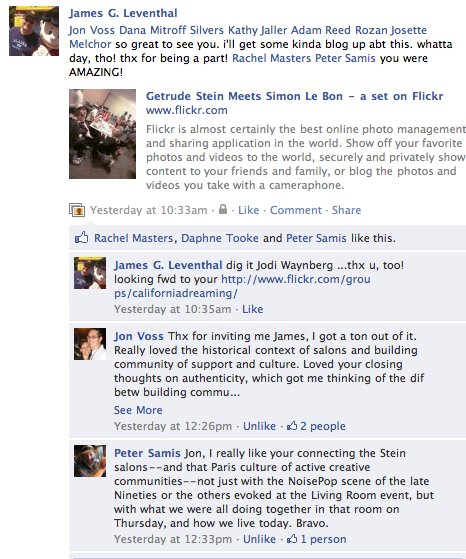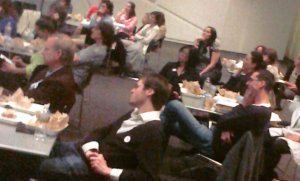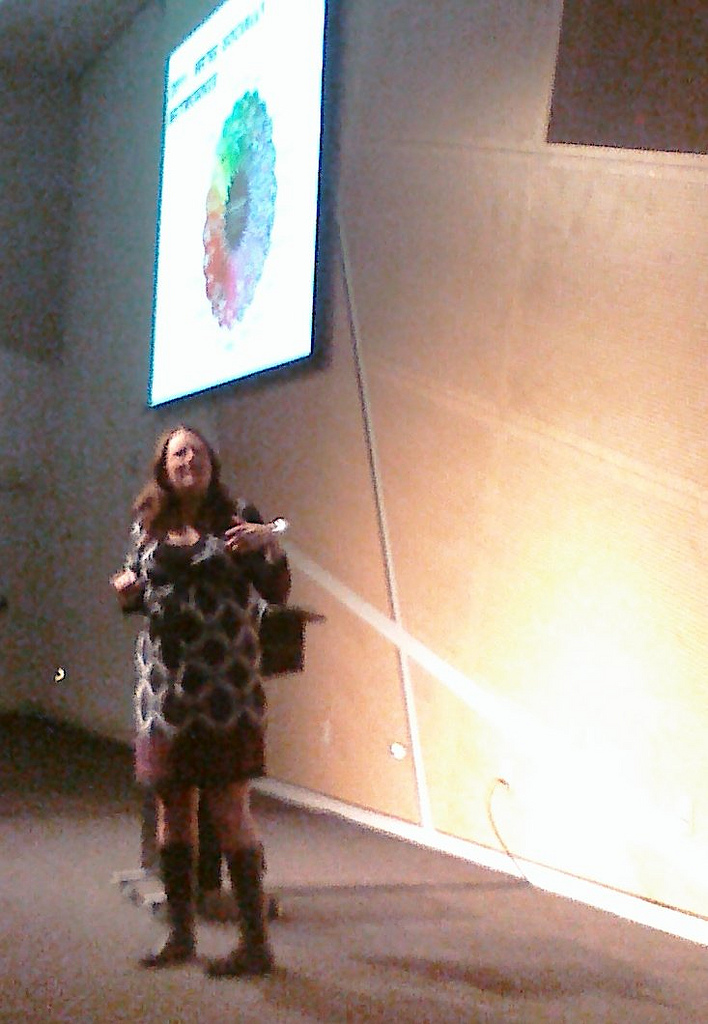Last Thursday, August 18th the Contemporary Jewish Museum welcomed 50 museum people from all over the greater San Francisco Bay Area -- from Golden Gate Park’s California Academy of Science to the Oakland Museum of California -- for a Network Lunch to talk about the use of new media to further our museums' educational missions through enhanced interpretation and marketing tools. Made possible with thanks to support from Guide by Cell and the Western Museums Association (WMA) the luncheon was entitled, “Gertrude Stein Meets Simon Le Bon.”
Peter Samis, Associate Curator, Interpretation, SFMOMA and Rachel Masters, Co-Founder, Red Magnet Media, were the lead presenters. Samis discussed the SFMOMA's work around the current exhibition The Steins Collect: Matisse, Picasso and the Parisian Avant-Garde and Masters discussed what her firm Red Magnet Media does with bands like Duran Duran, Linkin Park and Incubus.
Following there was be an audience-led discussion, considering other relevant projects and case studies, exploring the intersections of education and popular media in the use of technology in and around the museum space. Afterward the guests were encouraged to visit Seeing Gertrude Stein: Five Stories currently on display at the CJM.
Both presentations were rich and full of specific examples of how technological engagement with audiences has taken hold in the both the museum and for-profit worlds.
There are all kinds of moments you can trace back to as presaging today's DIY movement; sources and precedents for how we work now in our socially networked world, putting the microphone in the audience's hand, so to speak. Alexander Graham Bell calling out for someone on the line, or in the next room. Edison and the light bulb, allowing us to stay up all night working on our own projects. Stein's self-published work and her salons. Gysin and Burroughs' cut-ups. Warhol's fifteen minutes. One of my favorites is Greil Marcus’ take on giving the Sex Pistols credit from Lipstick Traces: A Secret History of the Twentieth Century:
…Johnny Rotten’s fist moments in “Anarchy in the U.K.” – a rolling earthquake of a laugh, a buried shout, then hoary words somehow stripped of all claptrap and set down in the city streets – I AM AN ANTICHRIST – remain as powerful as anything I know.
Marcus goes on to write:
What remains irreducible about this music is its desire to change the world. The desire is patent and simple, but it inscribes a story that is infinitely complex -- as complex as the interplay of the everyday gestures that describe the way the world already works. The desire begins with the demand to live not as an object but as subject of history – to live as if something actually depended on one’s action – and that demand opens onto a free street.
Now we are all producers, often demanding that our cultural offerings provide a context for us to be seen in the picture, for better or for worse, demanding ‘not to live as object but as subject of history.’
To be able to hear Peter Samis speak was just fantastic. In the museum world he is one of the progenitors, a new media guru and all around soothing, enriching and entertaining presenter. Samis talked about the development of in-gallery and on-line interpretive development being effectively driven by audience research, in an effort to answer the per-identified questions visitors had about the Steins and the exhibition. The Stein’s Collect has been one of the SFMOMA’s most successful exhibitions ever. Interestingly, one of the brilliant podcasts Samis and the SFMOMA team produced connects Gertrude Stein and her salons with the development of the Noise music movement in San Francisco in the 80s. Samis debuted the podcast for the group. Click here to download the free podcast.
Masters' presentation, as part of the WMA and Guide By Cell funded Network Lunch, was about the work that she does as a co-founder of Red Magnet Media and how they are developing digital experiences for bands like Incubus and Duran Duran. It was interesting to see how her team is tapping into an existing fan base and helping to add layers of content and meaning into the promotions of bands whose followings are dedicated no matter what the medium. Natural questions arose about how to find the intersection between the passion a smaller audience has for museums and the success of engaging larger audiences around popular music.
 In the end it came down to perhaps unresolvable questions of authenticity and meaning. In her recent Pulitzer Prize winning novel A Visit from the Goon Squad, Jennifer Egan tells a near-future story toward the end of the book about a young father who reluctantly takes work as a network weaver, of sorts. He feels insincere about it. So insincere he can’t even tell his wife:
In the end it came down to perhaps unresolvable questions of authenticity and meaning. In her recent Pulitzer Prize winning novel A Visit from the Goon Squad, Jennifer Egan tells a near-future story toward the end of the book about a young father who reluctantly takes work as a network weaver, of sorts. He feels insincere about it. So insincere he can’t even tell his wife:
He spent the afternoon trying – and failing – to tell Rebecca what he’d agreed to do for Bennie Salazar. Bennie had never used the word “parrot;” since the Bloggescandals, the term had become an obscenity. Even the financial disclosure statements that political bloggers were required to post hadn’t stemmed the suspicion that people’s opinions weren’t really their own….But Alex had promised Bennie fifty parrots to create “authentic word of mouth…Using his handset, he began devising a system for selecting potential parrots form his 15,896 friends.
The story goes on and Alex still can’t confess to his wife that he is the paid resource who is helping to promote a free concert for children and families in downtown Manhattan. And in the end he is no more resolved because he brings together a large group of parents and children to hear the show:
Alex and Rebecca and Cara-Ann were part of a throng of people that overwhelmed the sidewalk and filled the streets. Traffic had stopped, and choppers were converging...Today their military cackle felt weirdly appropriate, Alex thought, glancing around him at the sea of slings and sacs and baby backpacks. Older children carrying younger ones, because wasn’t this a kind of army? An army of children: the incarnation of faith in those who weren’t aware of having any left.
In the novel the scene gets prettier. There’s something promising and idyllic in the novel’s finale; all the while, there are tinges of the potential of misapplied mass communications on a grand scale, too.
We all left with questions of authenticity and meaning on our minds. If you were there, what was your take away?











Comments
James, thank you for this post. It sounded like an interesting and informative afternoon. I work at a small local history museum in the East Bay, and I would have loved to attend! Unfortunately, I am only now hearing about it. Was the event invite-only?
Maybe this is because I'm a product of my generation, but I don't see a necessary divide between digital interaction an meaning or authenticity. Ultimately for museum professionals, the goal of digital media is to get patrons into the building to experience the physical objects therein. But I think digital content can be considered on par with the physical. As a compliment rather than a replacement, digital media offers a more dynamic experience with that which is inside a museum. Also, if a museum's goal is education, there really need not be a digital/corporeal divide. Anything that educates is meaningful and authentic. As the generation of my nieces and nephews age and become adults, its undoubted that this will be solidified. Embracing the meaning and authenticity of the digital will allow us all to view digital content as more than a numbers booster or marketing ploy, which in turn will open up our minds the creating really meaningful content.
It was a great afternoon. I learned a lot.
Thanks for sharing, James. I hope you'll indulge me in a tangent!
Lately I've been parsing the difference between "informing" and "educating", looking often at very very thin line between the two, and allowing myself to got down the rabbit hole. Perhaps that is why "....a Network Lunch to talk about the use of new media to further our museums’ educational missions through enhanced interpretation and marketing tools." stood out to me (attention bias and all that jazz).
Then, with my partner in crime, I went to see a piece of live theater. Beforehand, we were given a piece of paper with ads and a text-based trivia game to play. If we answered the questions right, we were entered to win a prize relating to the show. (He won! Hooray.) The answers were easy enough for us, the "low hanging fruit already-fans" and easily answered correctly. While I wouldn't categorize this outright marketing, it smartly was. I wouldn't call it education, as I didn't learn anything beyond my own agenda of "how is this cultural organization utilizing tech for outreach?"
Do I have a question here? Sorta. Mostly wondering what the conversation was like between enhanced interpretation and marketing - if it was thought about in that manner. Clear as mud, yeah?
thank YOU, Marjorie, for sharing your thoughts here...you have a keen knack for getting at the heart of an issue...it's why there are so many out there in the field inspired by your leadership!
Kristen et al,
Thank you for crystallizing the key dichotomy here: do these new communication tools provide information or can they go further and provide education? The difference between the two, I think, is that the latter aims at a deeper inquiry and provocation, whereas the former simply aims to, if you will, inform from point of view of who is doing the informing. Advertising falls somewhere, in-between, I think; it is about influencing a desired behavior, like, "come visit our museum" or, more likely. "spend money on my product."
The early users of interactive technologies were pretty pure in their intentions and committed to education. Only when people figured out that there was money to be made (ie, James' great example from Goon Squad), did the whole thing begin to be about parsing information and leveraging the network in the name of financial objectives. And so, to get to the nagging question about "is it authentic?" Of course it is. Because authenticity is in the eye of the beholder. And good marketers are great rationalizers, so, as long as it's working in terms of numbers, then, dammit: it's authentic!
I think that it takes much more stamina and vision to keep pushing out toward education and critical thinking than it does to exploit a technology so it can deliver concrete numbers.
Anyway, thanks for a great post James.
all really good points!! thanks for keeping the conversation going...and as I tried to intimate in the blogpost itself and all of the "selling" of WMA and Guide By Cell, I think the lines between what we believe in, what we promote or market, etc...have become blurred/inextricably linked...
Dear Heather, Thank you for your comment. We tried to broadcast the invitation and it was public...please help us share this post, and we will try to keep in-mind for future events of this sort...it's all about inclusion. Where do you work? Post a link here, can you?
I'll email you and we can be sure to stay in-touch. Thanks!
Very interesting post, James. Like Heather, I would have loved to attend, but wasn't aware of the event (even though I work at Cantor with Kristen).
looks like we totally have to do this again...Thanks, Sara!
Add new comment